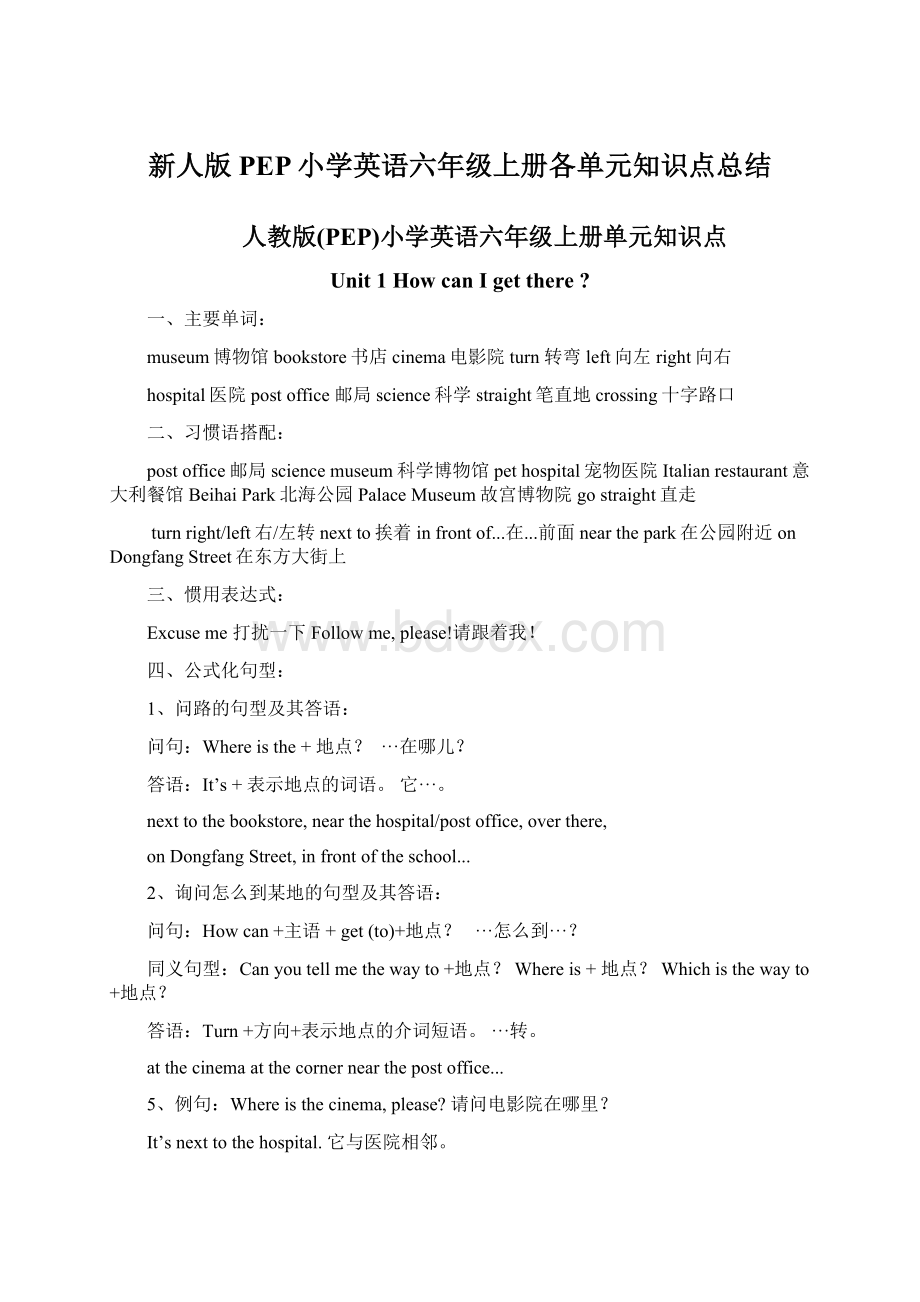新人版PEP小学英语六年级上册各单元知识点总结.docx
《新人版PEP小学英语六年级上册各单元知识点总结.docx》由会员分享,可在线阅读,更多相关《新人版PEP小学英语六年级上册各单元知识点总结.docx(11页珍藏版)》请在冰豆网上搜索。

新人版PEP小学英语六年级上册各单元知识点总结
人教版(PEP)小学英语六年级上册单元知识点
Unit 1 How canIgetthere?
一、主要单词:
museum博物馆bookstore书店cinema电影院turn转弯left向左right向右
hospital医院postoffice邮局science科学straight笔直地crossing十字路口
二、习惯语搭配:
postoffice邮局sciencemuseum科学博物馆pethospital宠物医院Italianrestaurant意大利餐馆BeihaiPark北海公园PalaceMuseum故宫博物院gostraight直走
turnright/left右/左转nextto挨着infrontof...在...前面nearthepark在公园附近onDongfangStreet在东方大街上
三、惯用表达式:
Excuseme打扰一下Followme,please!
请跟着我!
四、公式化句型:
1、问路的句型及其答语:
问句:
Whereisthe+地点?
···在哪儿?
答语:
It’s+表示地点的词语。
它···。
nexttothebookstore,nearthehospital/postoffice,overthere,
onDongfangStreet,infrontoftheschool...
2、询问怎么到某地的句型及其答语:
问句:
Howcan+主语+get(to)+地点?
···怎么到···?
同义句型:
Canyoutellmethewayto+地点?
Whereis+地点?
Whichisthewayto+地点?
答语:
Turn+方向+表示地点的介词短语。
···转。
atthecinemaatthecornernearthepostoffice...
5、例句:
Where is the cinema, please?
请问电影院在哪里?
It’s next to the hospital. 它与医院相邻。
Turn left at the cinema, then go straight. It’s on the left. 在电影院向左转,然后直行。
它在左边。
Turn left at the bank。
在银行左转。
六、主题写作:
介绍去某地的路线
模板:
1、交代目的地的位置及距离The…isnear/nextto…Itis(not)farfrom…
2、说明可以采取的交通方式Youcangoonfoot/bybus/bybike…
3、说明路线Gostraight.Turnleft/rightat…
范文HowtoGettotheScienceMuseum
Wearegoingtothesciencemuseumtomorrow.Thesciencemuseumisnexttothehospital.It’snotfarfromourschool.Sowecangothereonfoot.First,gostraightfromourschool.Next,turnleftatthepostofficeandwalkforaboutfiveminutes.Thenturnrightatthebookstore.Wecanfindthehospitalontheright.Walkstraight,andwe’llseethesciencemuseum.
Unit2Waystogotoschool
一、主要单词:
by乘bus公共汽车onfoot步行plane飞机taxi出租车ship(大)船
subway地铁train火车slow慢的stop停下 always 总是 usually 通常 often经常sometimes 有时候 never 从来不
2、习惯语搭配:
bybike/bus/plane/subway/train/ship/taxi/ferry骑自行车/乘公共汽车/飞机/地铁/火车/船/出租汽车/渡轮taketheNo.57bus乘57路公共汽车onfoot步行slowdown慢下来
payattentionto注意trafficlights交通信号灯lookright向右看crosstheroad横穿马路get off下车athome在家traffic rules交通规则 get to到达get on 上车
be far from…表示离某地远
三、惯用表达式:
Wait.等一等.Isee.我明白了.Go at a green light 绿灯行
Stop at a red light 红灯停 Wait at a yellow light 黄灯等
四、公式化句型:
1、如何询问对方的出行方式:
Howdoyoucome(to)+地点?
你(们)怎么来···的?
2、如何用must表示必须做某事:
某人+must+动词原形(+其它).···必须···。
3、告诫别人不要做某事的句型:
Don’t+动词原形(+其它)..不要/别···。
5、例句:
1.How do you go to school?
你怎么去上学?
2.Usually I go to school on foot. Sometimes I go by bus. 通常我步行去上学。
有时候骑自行车去。
3.How can I get to Zhongshan Park ?
我怎么到达中山公园?
4.You can go by the No. 15 bus.你可以坐15路公共汽车去。
5.I am far from school now. 我现在离学校很远。
6.My home is not far from ourschool.Myhomeisnearourschool.我家离学校不远。
六、主题写作:
介绍去上学所采用的出行方式
模板:
1、说明自己家到学校的距离Myhomeis(not)farfrom/neartheschool.
2、说明自己的出行方式Ioften/usuallygotoschool…SometimesIgo…
3、说明选择该出行方式的原因或好处Itisgoodexercise./Itisfast.
范文Don’tBeAgainsttheTrafficRules
IgotoschoolfromMondaystoFridays.Igotoschoolbybikeat7:
30inthemorning.Ihavetocrosstwobusyroads.Iknowthetrafficruleswell.Slowdownandstopatayellowlight.Stopandwaitataredlight.Goatagreenlight.Ialwaysrideontherightsideoftheroad.Iamneveragainstthetrafficrules.
Unit3Myweekendplan
一、主要单词:
tomorrow明天film电影supermarket超市trip旅行tonight在今晚
evening晚上/傍晚nextweek下周comic连环画杂志dictionary词典word单词
postcard明信片visit拜访
二、习惯搭配:
takeatrip去旅行goforapicnic去野餐gotothecinema去看电影
learntoswim学习游泳visitmygrandparents看望我(外)祖父母gettogether聚会
gotothesupermarket去超市goice-skating去滑冰makeasnowman堆雪人seeafilm看电影
makemooncakes做月饼readapoem朗诵一首诗thisweekend这周末RenminPark人民公园
nextweek下周thismorning/afternoon/evening今天上午/下午/晚上nextWednesday下星期三
三、惯用表达式:
Whataboutyou?
你呢?
Heretheyare!
它们在这儿!
CanIhelpyou?
我能帮助你吗?
Soundsgreat!
听起来很棒!
Haveagoodtime!
玩得开心!
Youtoo.你也是
四、公式化句型:
1、询问对方打算做什么的句型及其答语:
问句:
Whatareyougoingtodo+其它?
你/你们···打算做什么?
nextweektonighttomorrowthismorning/afternoon/eveningthisweekend...
答语:
I’m/We’regoingto+动词(短语)原形+其它.我/我们打算···。
seeafilmtakeatripvisitmygrandparentswatchTV...
2、询问对方打算去哪儿的句型及答语:
问句:
Whereareyougoing(+将来时间)?
你/你们打算(···)去哪儿?
答语:
I’m/We’regoing(tothe)+地点.我/我们打算去···。
3、询问对方打算何时去做某事的句型及答语:
问句:
Whenareyougoingto+动词(短语)原形?
你/你们打算什么时候···?
答语:
I’m/We’regoingto+动词(短语)原形+将来时间.我/我们打算···。
5、例句:
What are you going to do on the weekend?
你周末打算做什么?
I’m going to visit my grandparents this weekend?
这个周末我打算去看望我的外祖父母。
Where are you going this afternoon?
你今天下午打算去哪里?
I’m going to the bookstore.我打算去书店。
What are you going to buy?
你打算去买什么?
I’m going to buy a comic book。
我打算去买一本漫画书。
6、主题写作:
制订周末计划
模板:
1、说明一下自己打算过个怎样的周六Iamgoingtohaveabusy/great/…day.
2、按时间顺序,介绍自己打算做的事I’mgoingto+动词(短语)原形+将来的时间。
范文Let’sHaveaNiceDay!
TodayisSaturday.TomorrowmorningI’mgoingtothebookstorewithmyfriends.Wearegoingtolookforsomegoodbooks.Wealllikereadingbooks.Wearegoingtohavelunchinarestaurant.Ilikechicken,beefandvegetables.Afterlunch,wearegoingtotheSummerPalacebybus.WearegoingtoplayneartheKunmingLake.Maybewearegoingtorowaboatonthelake.Thatwillbegreat!
Wearecomingbackat5intheafternoon.
Unit4Ihaveapenpal
一、主要单词:
studies学习(第三人称单数形式)puzzle谜hiking远足
二、习惯搭配:
readstories读故事dokungfu练功夫flykites放风筝playthepipa弹琵琶
playsports进行体育活动climbmountains爬山listentomusic听音乐
singEnglishsongs唱英文歌onafarm在一个农场里livein...住在···
writeanemailto...给···写一封电子邮件ontheplayground在运动场上
三、惯用表达式:
Metoo.我也是。
Really?
真的吗?
四、公式化句型:
1、询问某人爱好的句型及其答语:
问句:
Whataresb.’shobbies?
···有什么爱好?
答语:
主语+like/likes+动词-ing形式(+其它).···喜欢···。
SingingdancingreadingstoriesplayingfootballdoingkungfudoingwordpuzzlesgoinghikingwatchingTVdrawingcartoonslisteningtomusicgoingfishing
2、由do/does引导的一般疑问句及其答语:
问句:
Do/Does+主语+动词原形+其它?
答语:
Yes,主语+do/does./No,主语+don’t/doesn’t.
5、语法:
1、动词变为动名词的规则:
动词变为动名词,即是动词加ing。
一般要遵循以下三条规则:
(1)一般情况下,在动词的后面直接加ing。
如:
play—playing read—reading do—doing go—going
(2)以不发音的字母e结尾的动词,要去掉不发音的字母e,再加ing。
如:
write—writing ride—riding make—making dance—dancing
(3)以单元音加单辅音结尾的重读闭音节,要双写最后一个辅音字母,再加ing。
如:
run—running swim—swimming put—putting sit—sitting
2、关于第三人称单数:
动词变为第三人称单数形式的规则:
(1)在一个句子中,如果主语人称既不是你,也不是我,而是另外的一个人,这时的人称叫做第三人称单数。
(2)在第三人称单词的句子中,动词要使用第三人称单词形式。
(3)动词变为第三人称单数形式,要遵循以下规则:
①一般情况下,在动词的后面直接加s。
如:
read--reads make—makes write—writes
②以字母s, x, o , sh , ch结尾的动词,在词尾加es。
如:
do—does wash—washes teach—teaches go—goes pass—passes
③以y结尾的动词分为两个情况,以元音字母加y结尾的动词,在词尾直接加s。
如:
play—plays buy--buys
以辅音字母加y结尾的动词,要把y变为i,再加es.如:
study--studies
④以f , fe结尾的名词,先把f,fe变为v,再加-es.
⑤特殊变化:
have--has
(4)在一个第三人称单数的句子中,只要句子中出现了does或者其否定形式doesn’t.该句子中的其他动词就要使用原形。
(5)第三人称单数的肯定句在变为否定句时,在动词的前面加doesn’t. 动词恢复原形。
如:
he lives in Beijing.---he doesn’t live in Beijing.
(6) 第三人称单数的陈述句在变为一般疑问句时,用does开头,后面的动词也要变为原形。
如:
he lives in Beijing.---Does he live in Beijing?
3、注意几个单词的变化:
hobby(复数形式)—hobbies have to(同义词)—must
6、反义词或对应词:
get on(上车)---get off(下车) near(近的)—far(远的)left(左)---right(右)
fast(快的)—slow(慢的) because(因为)—why(为什么) same(相同的)—different(不同的)get on (上车)---get off(下车) here(这里)---there(那里)east(东)---west(西) north(北)---south(南)
近义词:
see you---goodbye sure---certainly---of course
七、主题写作:
介绍笔友的特征及爱好
模板:
开头:
交代人物的身份Ihaveanewpenpal.His/Hernameis+姓名。
中间:
1、年龄He/Sheis+数字+year(s)old.
2、外貌He/Sheis+表示高、矮、胖、瘦的形容词.He/Shehas+描述外貌特征的词组.
3、性格He/Sheis+表示性格特点的形容词.
4、爱好He/Shelikes+动词的-ing形式.He/Sheusually+动词(短语)…
结尾:
评价人物或抒发对人物的情感Whata/an+形容词+boy/girl!
Ilikehim/herverymuch.
范文LiYing’sHobbies
LiYinglikesEnglishverymuch.Sheworkshardatit.ShereadsEnglisheverymorning.ShelikesspeakingEnglish.Shelikeslisteningtotheradio,too.ShewatchesTVonlyonSaturdayevening.
DoesshelikecookingChinesefood?
No,shedoesn’t.Shelikesdoingwordpuzzles.Shedoesn’tlikeplayingbasketball.Herparentsloveher.Alltheteachersloveher,too.Shesaysherhobbiesmakeherhappy.
Unit5Whatdoeshedo?
一、重点单词:
factory工厂postman邮递员policeofficer警察fisherman渔民scientist科学家pilot飞行员coach教练businessman商人;企业家worker工人
二、习惯搭配:
bycar/bus/bike/plane/boat乘小汽车/公共汽车/自行车/飞机/船gotowork去上班
studyhard努力学习stayhealthy保持健康gohome回家lotsof许多
gotothecamp去度假营begoodat...擅长···
三、惯用表达式:
Cool!
酷!
Whataboutyou?
你呢?
That’snice.那真好。
Isee.我明白了。
四、公式化句型:
1、询问他人的职业的句型及其答语;
问句:
Whatdoes+主语(第三人称单数)+do?
···是做什么的?
答语:
He/Sheisa/an+职业名称.他/她是一位···。
workerpostmanbusinessmanfishermanscientistpilotcoach
policeofficersalesperson售货员cleaner清洁工teacherdancer舞蹈演员
doctornurse护士pianist钢琴家dentist牙医tailor裁缝
2、询问他人的工作地点的句型及其答语:
问句:
Wheredoes+主语(第三人称单数)+work?
···在哪儿工作?
答语:
He/Sheworks+(表示地点的)介词短语.他/她···工作。
atauniversityinagymatseaonaboatatthezoo
inaschoolinabank在一家银行inacarcompany在一家汽车公司
3、询问他人的上班方式的问句及其答语:
问句:
Howdoes+主语(第三人称单数)+gotowork?
···怎么去上班?
答语:
He/Shegoestowork+交通方式.他/她···去上班。
bybike/bus/subway/plane/train/ship/ferry/...onfoot
五、一些由动词变化而来的职业名词:
teach—teacher clean—cleaner sing—singer dance—dancer
drive—driver write—writerTV report—TV reporter act—actor
act—actress art—artist engine—engineer
六、主题写作:
家人的职业及出行方式
模板:
1、描述家人的职业My+称谓+isa/an+职业名词.
2、描述家人的工作地点He/Sheworksin/on/at+地点.
3、描述家人去上班的交通方式He/Shegoestoworkonfoot/by+交通工具.
范文
ILoveMyFamily
Hereisaphotoofmyfamily.Therearefourpeopleinmyfamily.Theyaremyfather,mymother,mybrotherandme.
Myfatherisadoctor.Heworksinahospital.Hegoestoworkbysubway.Mymotherisateacher.Sheworksinaschoolnearmyhome.Shegoestoworkbybike.Look,thetallboyismybrother.Heisolderthanme.Heis